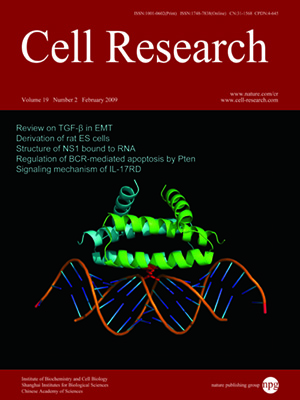
Volume 19, No 2, Feb 2009
ISSN: 1001-0602
EISSN: 1748-7838 2018
impact factor 17.848*
(Clarivate Analytics, 2019)
Volume 19 Issue 2, February 2009: 216-233
ORIGINAL ARTICLES
Adipogenesis licensing and execution are disparately linked to cell proliferation
Wei Guo1,2,*, Kun-Ming Zhang1,2,*, Kang Tu1, Yi-Xue Li1, Li Zhu1, Hua-Sheng Xiao1,3, Ying Yang1,2 and Jia-Rui Wu1,2,4
1Key Laboratory of Systems Biology, Institute of Biochemistry and Cell Biology, Shanghai Institutes for Biological Sciences, Chinese Academy of Sciences, 320 Yue-Yang Road, Shanghai 200031, China
2State Key Laboratory of Molecular Biology, Institute of Biochemistry and Cell Biology, Shanghai Institutes for Biological Sciences, Chinese Academy of Sciences, 320 Yue-Yang Road, Shanghai 200031, China
3National Engineering Center for Biochip at Shanghai, 151 Libing Road, Zhangjiang Hi-Tech Park, Shanghai 201203, China
4Hefei National Laboratory for Physical Sciences at Microscale and School of Life Sciences, University of Science & Technology of China, Hefei, Anhui 230027, China
Correspondence: Jia-Rui Wu,(wujr@sibs.ac.cn)
Coordination of cell differentiation and proliferation is a key issue in the development process of multi-cellular organisms and stem cells. Here we provide evidence that the establishment of adipocyte differentiation of 3T3-L1 cells requires two processes: the licensing of an adipogenesis gene-expression program within a particular growth-arrest stage, i.e., the contact-inhibition stage, and then the execution of this program in a cell-cycle-independent manner, by which the licensed progenitors are differentiated into adipocytes in the presence of inducing factors. Our results showed that differentiation licensing of 3T3-L1 cells during the contact-inhibition stage involved epigenetic modifications such as DNA methylation and histone modifications, whereas disturbing these epigenetic modifications by DNA methylation inhibitors or RNAi during the contact-inhibition stage significantly reduced adipogenesis efficiency. More importantly, when these licensed 3T3-L1 cells were re-cultured under non-differentiating conditions or treated only with insulin, this adipogenesis commitment could be maintained from one cell generation to the next, whereby the licensed program could be activated in a cell-cycle-independent manner once these cells were subjected to adipogenesis-inducing conditions. This result suggests that differentiation licensing and differentiation execution can be uncoupled and disparately linked to cell proliferation. Our findings deliver a new concept that cell-fate decision can be subdivided into at least two stages, licensing and execution, which might have different regulatory relationships with cell proliferation. In addition, this new concept may provide a clue for developing new strategies against obesity.
Cell Research (2009) 19:216-223. doi: 10.1038/cr.2008.319; published online 9 December 2008
FULL TEXT | PDF
Browse 2103


